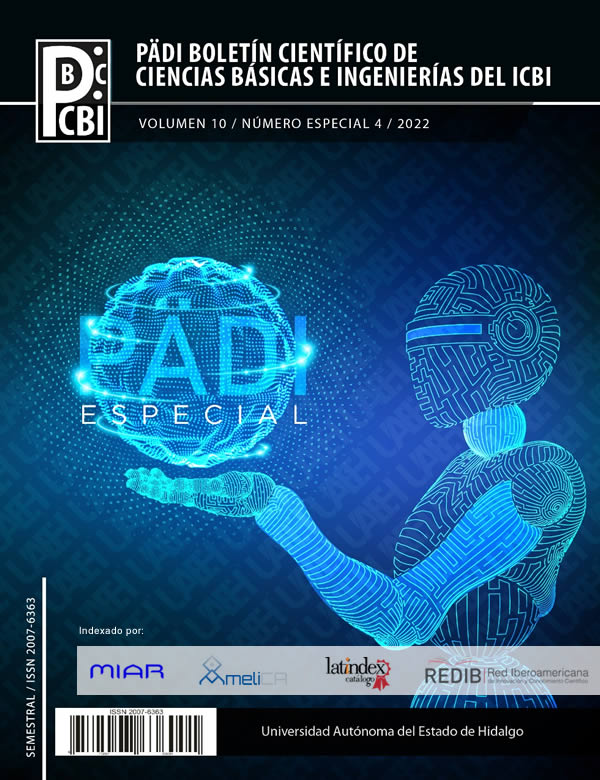Neuroevolución de redes neuronales híbridas en un agente robótico (NRNH-AR)
DOI:
https://doi.org/10.29057/icbi.v10iEspecial4.9070Palabras clave:
Edge Computing, Aprendizaje por Refuerzo Profundo, Neuroevolución,, DDPG, Política de GradienteResumen
Se ha desarrollado un Agente Robótico capaz de aprender del entorno dinámico por el que navega, el cual tiene como objetivo hallar un objeto específico. Para el crecimiento de su aprendizaje, se ha creado la Neuroevolución de Redes Neuronales Híbridas en un Agente Robótico (NRNH-AR) que combina redes como la CNN para entender el entorno y ANN para realizar acciones, esto se complementa con el Aprendizaje por Refuerzo Profundo y la Política de Gradiente. Sin embargo, para que el algoritmo tenga éxito prácticamente en un robot físico, se han considerado además dos bloques: el Hardware y la mecánica involucrada, pues se entrenará de forma on-line para evitar problemas de latencia y limitación de ancho de banda. Con esta investigación, se ha demostrado que con la NRNH-AR es posible implementar el Aprendizaje por Refuerzo Profundo dentro de un Robot, optimizando en tiempo y costo computacional teniendo un aprendizaje evolutivo.
Descargas
Información de Publicación
Perfiles de revisores N/D
Declaraciones del autor
Indexado en
- Sociedad académica
- N/D
Citas
Chen, W., Zhou, S., Pan, Z., Zheng, H., Liu, Y (2019). Mapless Collaborative Navigation for a Multi-Robot System Based on the Deep Reinforcement Learning. Volume26 Issue 5 doi: 10.3390/app9204198
Diaz-Arango, G., Vazquez-Leal, H., Hernandez-Martinez, L., Jimenez-Fernandez, V. M., Heredia-Jimenez, A., Ambrosio, R. C., Huerta-Chua, J., De Cos-Cholula, H., Hernandez-Mendez, S. (2020). Multiple-Target Homotopic Quasi-Complete Path Planning Method for Mobile Robot Using a Piecewise Linear Approach. MDPIST ALBAN-ANLAGE 66, Ch-4052 Basel, Switzerland. Volume 20, Issue 11, Article Number 3265, doi: 10.3390/s20113265
Dong Gi, G., Kyon Mo, Y., Min Ro, P., Jehun, H., Jaewan, K., Joonwoo, L., Kap Ho, S. (2021). Marker-Based Method for Recognition of Camera Position for Mobile Robots. Sensors 2021, 21, 1077. Doi: 10.3390/s21041077
Faisal, M., Hedjar, R. Sulaiman, M. A. (2013). Fuzzy Logic Navigation and Obstacle Avoidance by a Mobile Robot in an Unknown Dynamic Environment. International Journal of Advanced Robotic Systems, College of Computer and Information Sciences, King Saud University, Saudi Arabia. doi: 10.5772/54427
Fujimoto, S., Hoof, H., Meger, D. (2018). Addressing Function Approximation Error in Actor-Critic Methods. Proceedings of the 35 th International Conference on Machine Learning, Stockholm, Sweden PMLR 80.
Gon-Woo, K (2014). Expanded Guide Circle-based Obstacle Avoidance for the Remotely Operated Mobile Robot. Springer singapore pte ltd#04-01 cencon i, 1 tannery rd, Singapore 347719, SINGAPORE. Volume 9, Issue 3, Page 1034-1042, doi: 10.5370/JEET.2014.9.3.1034
Grigoryeva, S., Alimkhanova, A., Batalova, M. (2021). Research of indoor temperature data transmission using visible light communication technology. IMET 2020 Journal of Physics: Conference Series. 1843 012004 doi: 10.1088/1742-6596/1843/1/012004
İrem, M., Alper, K. T., Beyda, T. Ahmet, B. T., Oğuz, Y. (2020). FUHAR: A transformable wheel-legged hybrid mobile robot. Elsevierradarweg 29, 1043 nx amsterdam, netherlands. Volume 133, Article Number 103627. Doi: 10.1016/j.robot.2020.103627
Lepej, P., Maurer, J., Uran, S. (2015). Dynamic Arc Fitting Path Follower for Skid-steered Mobile Robots. Sage publications INC2455 Teller rd, thousand Oaks, CA 91320. Volume 12, Article Number 139, doi: 10.5772/61199
Li, N., Zhao, X., Yang, Y., Zou, X. (2016). Objects Classification by Learning-Based Visual Saliency Model and Convolutional Neural Network. Hindawi ltdadam house, 3rd flr, 1 fitzroy sq, London w1t 5hf, England. Volume 2016, Article Number 7942501. Doi: 10.1155/2016/7942501
Lillywhite, K., Lee, D., Tippetts, B., Archibald, J. (2013). A feature construction method for general object recognition. Pattern Recognition, vol. 46, no. 12, pp. 3300–3314, doi: 10.1016/j.patcog.2013.06.002.
Lindeberg, T. (2012), Scale invariant feature transform. Scholarpedia, vol. 7, no. 5, pp. 2012–2021. Doi: 10.4249/scholarpedia.10491
Lowe, D.G. (2004). Distinctive Image Features from Scale-Invariant Keypoints. International Journal of Computer Vision 60, 91–11 doi: 10.1023/B:VISI.0000029664.99615.94
Lv, P., Wang, X., Cheng, Y., Duan, Z. (2019). Stochastic Double Deep Q-Network. National Natural Science Foundation of China, 61772532. Doi: 10.1109/ACCESS.2019.2922706
Ma, L., Alborati, M. (2019). Wireless Inter-Vehicle Communication among VEX Robots. Proceedings of the 2019 IEEE 11th International Conference on Engineering Education, ICEED 2019 8994949, pp. 78-83 doi: 10.1109/ICEED47294.2019.8994949.
Marjovi, A., Marques, L. (2011). Multi-robot olfactory search in structured environments. Robotics and Autonomous Systems. 59867-881. doi: 10.1016/j.robot.2011.07.010
Me_k_tronico. (2020). Cinemática de robot móvil tipo triciclo. [Archivo de video]. https://www.youtube.com/watch?v=3xKEOaKttos
Oscar Ramos (2021). Cinemática de Robots Móviles (parte 1/2). [Archivo de video]. https://www.youtube.com/watch?v=2Asd4RH3Gmw
Placed, J., Castellanos, J. (2020). A Deep Reinforcement Learning Approach for Active SLAM. Applied science,10, 8386. doi:10.3390/app10238386
Raja, P., Pugazhenthi, S. (2012). On-line path planning for mobile robots in dynamic environments. Neural network world. Volume 22, Issue 1, Page 67-83. Doi: 10.14311/NNW.2012.22.005
Satyanarayanan, M. (2017) The Emergence of Edge Computing. Computer 50(1):30–39. Doi: 10.1109/MC.2017.9
Stateczny, A., Gierlowski, K., Hoeft, M (2022). Wireless Local Area Network Technologies as Communication Solutions for Unmanned Surface Vehicles. Sensors 2022, 22, 655. Doi: 10.3390/s22020655
Tao Z., Jian W., Jilin Z., Congfeng J. (2022). Deep Reinforcement Learning-Based Workload Scheduling for Edge Computing. Journal of Cloud Computing: Advances, Systems and Applications, doi: 10.1186/s13677-021-00276-0
Vasquez-Jalpa, C., Nakano-Miyatake, M., Escamilla Hernandez, E. (2021). A deep reinforcement learning algorithm based on modified Twin delay DDPG method for robotic applications. 21st International Conference on Control, Automation and Systems (ICCAS), pp. 743-748, doi: 10.23919/ICCAS52745.2021.9649882.
Wang, H., Shi, J. (2019). Design and Modeling of a Novel Transformable Land/Air Robot. Hindawi ltdadam house, 3rd flr, 1 fitzroy sq, London w1t 5hf, England. Volume 2019, Article Number 2064131, doi: 10.1155/2019/2064131
Wróbel, K., Karwatowski, M., Wielgosz, M., Pietroń M., Wiatr, K. (2020). Compressing sentiment analysis cnn models for efficient hardware processing. Computer Science, 21(1). Doi: 10.7494/csci.2020.21.1.3375
Zhu, K, Zhang, T (2021). Deep Reinforcement Learning Based Mobile Robot Navigation: A Review. Volume26 Issue 5 Page 674-691. Doi: 10.26599/TST.2021.9010012




















